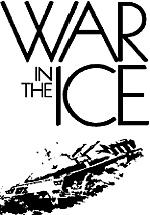 War in the Ice: The Battle for the Seventh Continent, 1991-92
War in the Ice: The Battle for the Seventh Continent, 1991-92
SPI 1978
A Future History/Science Fiction Simulation Game
the time is: 4 November, 1991
Designed by Phil Kosnett
Components
1 bookcase-style cardboard box
1 22"x34" unmounted game map
1 24-page rulebook & background notes 400 backprinted counters
Each land unit has Anti-armor, Anti-infantry, Anti-air, and Electronic Warfare (EW) strengths. Each air unit has Anti-ground, Air Combat, and EW strengths as well as Range.
Unit Types
Land Units
- Mechanized Combat Task Force; Droid Team; Laser Battery; Van Convoy; and Hovertank Team.
Land Units: Infantry Engineer Brigade; Garrison; Airmobile Team; and Paratroop Battalion.
Air Units
- Fighter; Ground Attack/Spotter; Electronic Warfare; Light Transport; Heavy Transport; Transport Helicopter; and Attack Helicopter.
Satellite Units
- STAR (Satellite Targeted Recon); MARS (Maneuverable Recon Satellite); and KISS (Killer Satellite)
Installations
- Temporary Base; and Sensor
Subterran Units
- “Sleeper” Infantry; Ice Drill; Converter; Lifter; and Psimaster.
Markers
- Primary Base Supply; Secondary Base Supply; Temporary Base Supply; Van Convoy Supply; Heavy Transport
Supply; Light Transport Supply; Transport Helicopter Supply; Detected/Unsupplied; Orbit Reference; and
Tactical Option Chit.
Factions
USA; USSR; SAU (South American Union); and Subterrans (in the science fiction scenario).
The standard game of War in the Ice portrays a near-future conflict of limited war over Antarctica, between two (USA vs. USSR), or three (USA vs. USSR vs. SAU) players. There is also a science fiction scenario, which posits the existence of Subterrans in Stasis on the Antarctican continent. These are actually said to be descended from some long forgotten human civilization of Earth (such as Mu), as opposed to aliens from space. They awake during the war between the modern human powers, and endeavor to push the modern powers out of Antarctica.
Most of the background material on the conventional, near-future war appears ridiculous today, especially in regard to politics. The Subterran concept is even more silly. However, the game system itself is interesting, as a rendering of near-future combat. It could be an interesting exercise to try to transfer it to other situations/environments.
Suggestion: ignore the Subterrans entirely. This can only be an alternative history to the near-future history of SPI. the time is: 4 November, 2011
Factions
USA {USA}; Europa and Russia {USSR}; and Unia America Latina & Chung-kuo {SAU}.
Background
Having absorbed most of Canada in the aftermath of the Canadian Civil War, the U.S. still finds it needs further energy supplies for its highly consumerist economy, and endeavors to begin exploitation of the vast oil, coal, and uranium reserves that have been recently discovered in Antarctica. The other, less rich powerblocs, also hunger after these reserves.
However, all the powers have to be careful not to expend too extensive resources on the war — hence, its limited nature. In the three-cornered struggle, none of the powers emerges with a real victory. The U.S. is somewhat successful in the military campaign, but at too great a cost in resources. The peace agreement of 2012 restore the status quo ante.
References
Short reviews appeared in Paper Wars 7 and Ares 1.
Collector’s Value
Boone quotes low, high and average prices of 3/55/20.26 at auction and 12/50/29.26 for sale.
Other Games by This Designer
Airborne! (JagdPanther 1976);
Yugoslavia (SPI 1977); Acre (SPI 1978);
Titan Strike (SPI 1979);
Helltank (Metagaming 1981); and
Helltank Destroyer (Metagaming 1982).
Other Games of This Type
None, really.
Back to Simulacrum Vol. 3 No. 3 Table of Contents
Back to Simulacrum List of Issues
Back to MagWeb Master Magazine List
© Copyright 2001 by Steambubble Graphics
This article appears in MagWeb (Magazine Web) on the Internet World Wide Web. Other military history articles and gaming articles are available at http://www.magweb.com